If you're a plumber looking to grow your plumbing business, consider ways to improve your plumbing website design. Your website is the first impression for potential customers and can make a positive or negative impact in terms of what they remember about your local plumbing business.
To help you get started, we've put together a quick list of 5 tips for you to consider when developing your website, along with some great examples to get you inspired.
1. Customer Testimonials Front and Center
A quality plumbing website should have customer testimonials prominently displayed so that potential customers can see how satisfied customers were with your service. This will help you convince new customers that they should trust your company to do a great job for them, too.
Customers who are happy with the work you've done for them will write testimonials (especially if you ask them to) and be honest about what you did for them. For example, if you solved a plumbing problem for a customer, they will usually say so in their testimonial. If you were able to fix something that another plumber couldn't, your customers might mention that.
The idea is to give potential customers a reason to trust you and your company. They want to know that they're getting their money's worth, and that means reading testimonials from satisfied customers. Arrange the testimonials on your primary landing page, with a link to it from the page where you display your services. You can also include testimonials on your social media channels, such as Facebook or LinkedIn, as well as any Google ads campaigns that you begin later on.
Example
One plumber website design that makes really great use of customer testimonials is MCH Nashville. Their website displays them directly on their home page, with a simple call to action to contact the company. The testimonials are neatly arranged, each one telling short stories about what the company has done for its customers. They're also very realistic, describing real-life problems and how MCH Nashville was able to solve them.
That's the kind of testimonial that can really help you sell your plumbing service to prospective customers. Design your own website to showcase your business and its services. If you're not a web designer, there are plenty of website templates available that can be customized to fit your needs.
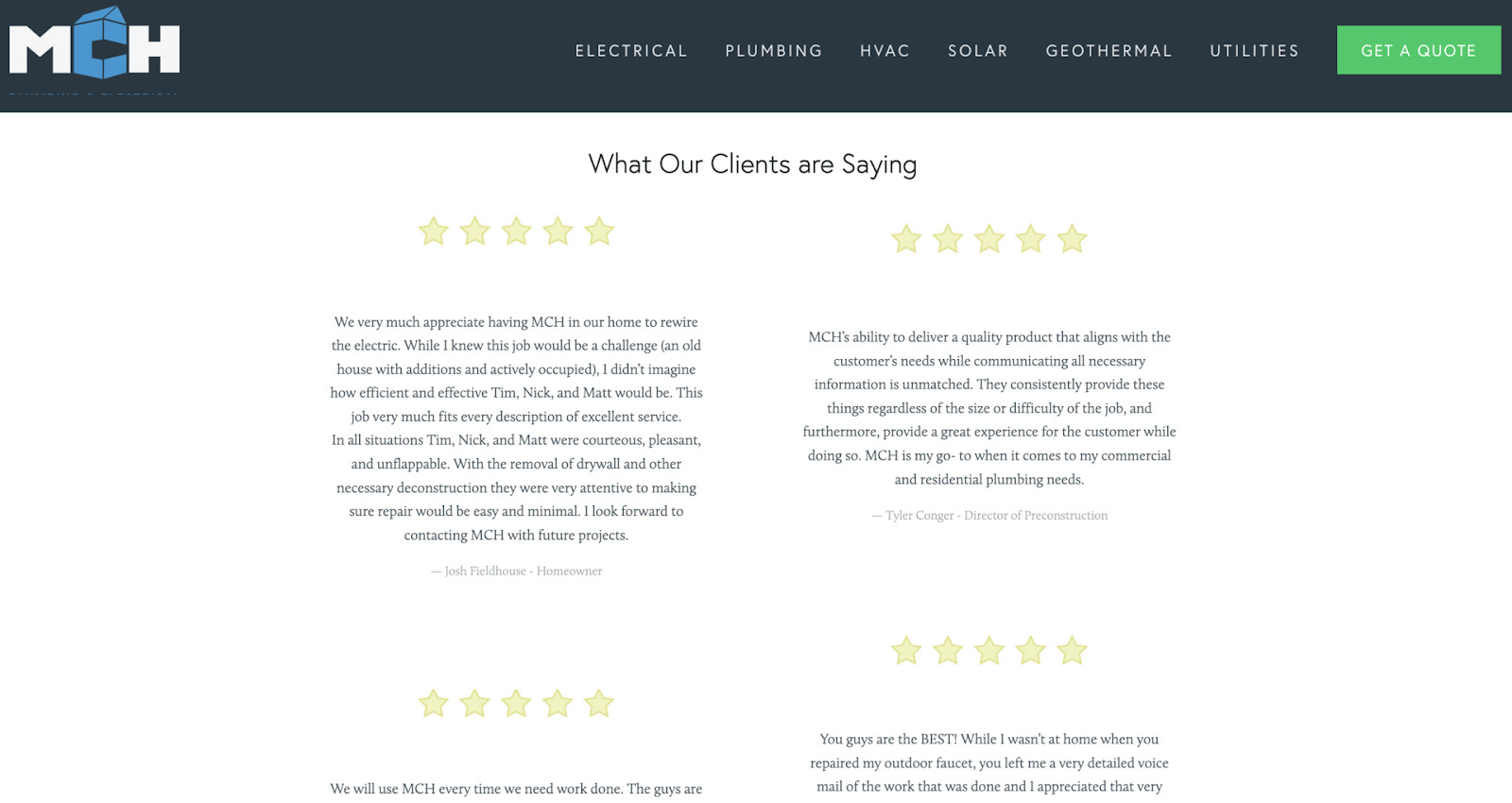
2. Bullet Points for Scannability
Bullet points are a quick and easy way to get your message across. They're great for scannable content like blog posts, product descriptions, and landing pages. Bullet points allow you to break up large blocks of text into smaller chunks so that readers can quickly scan through them without getting overwhelmed.
As powerful digital marketing tools, you can use bullet points to achieve two goals:
- Summarize the most important points about your company and services
- Make it easy for people to scan the page for information on a specific topic.
Bullets should be short, succinct, and use active language. They should also be placed in a logical order that makes sense to the reader. Most importantly, they need to be relevant to your target audience.
The more you can engage users with bullet points, the better they will understand what you're trying to communicate with your content. It's easy to get carried away, but a good rule of thumb is if you can't fit your message in one line, it's probably too long.
Keep in mind that not everyone will read the same content from beginning to end. A website visitor may skim through, looking for specific information. So be sure that each bullet point contains enough information so someone who is reading quickly can understand what they need without having to read further. That can streamline your user experience and make your website easier to use.
Example
The bullets used by Hillcrest Plumbing provide an excellent example of how to use bullets effectively. The company uses them to summarize the most important points about their services and explains what sets them apart from other plumbing contractors in the area.
Hillcrest's bullet points also contain a lot of white space, which makes them easy to scan. This is a great way to ensure that your reader doesn't get distracted by unnecessary information or lose interest in your content. In other words, it keeps website visitors reading and interested in what Hillcrest has to say.
The bottom line is that bullets are a great way to make sure your content is easy to digest. They're also an effective way of ensuring that your point gets across without using too many words or paragraphs, which can overwhelm a reader easily.
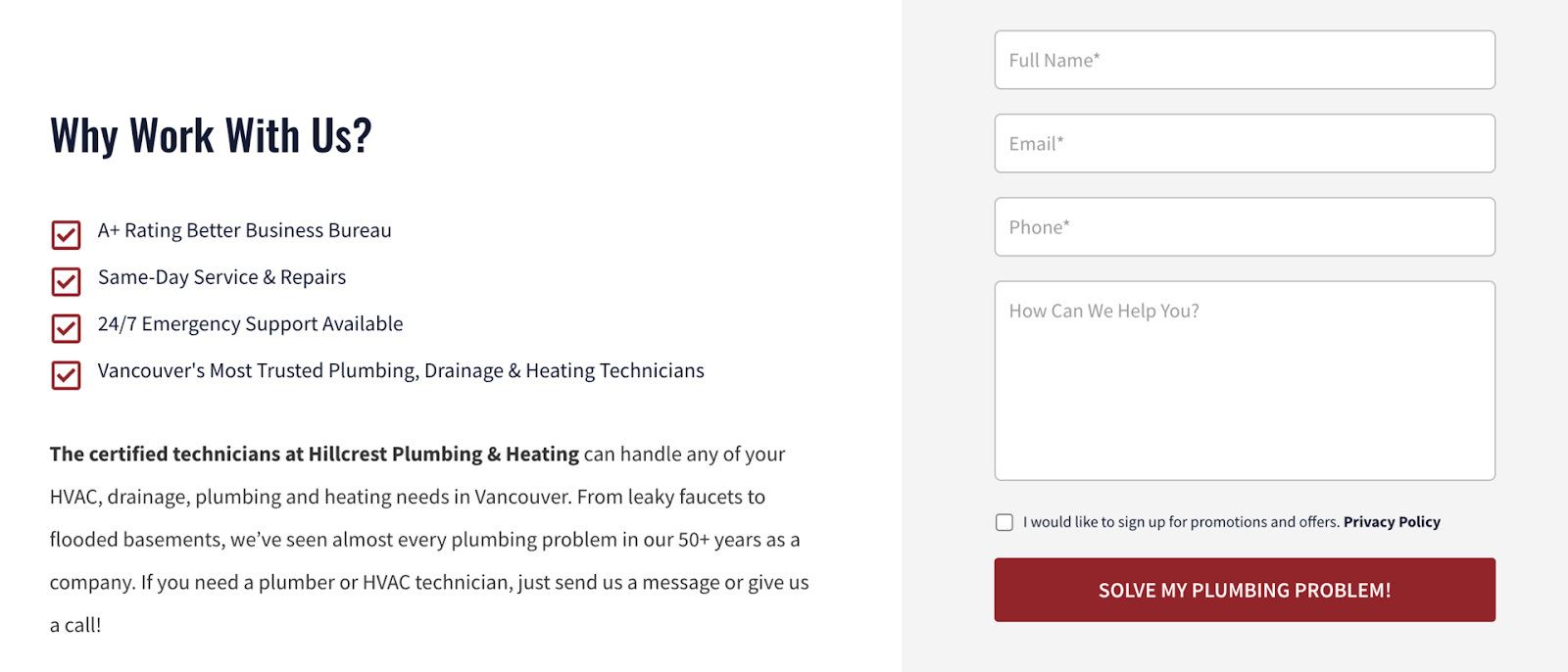
3. Clear Call to Actions
Customers visiting your plumbing company's website for the first time should have no confusion about what you want them to do. A call to action (CTA) is a phrase or sentence that tells people what you want them to do once they’ve finished reading your page. For example: “Schedule an appointment with one of our plumbers today!”
Calls to action should be explicit and direct. Don’t leave customers guessing what you want them to do — make it crystal clear with a strong message explaining how they can take action. The CTA should be placed in a prominent location on your page. For example, you may want to place it above the fold (appearing before scrolling down) or below the fold (appearing after scrolling down).
CTAs in web design should be bold and stand out from the rest of the page. This is because visitors will scan your page first before deciding whether to read everything on it.
The call-to-action button should be large enough so that people can easily see it. Plus, it should be placed in a location that makes sense for your website. For example, if you have a blog post about fixing kitchen sinks, don't put your call-to-action button in the middle of something unrelated.
Example
Mr. Rooter Plumbing provides us with an example of excellent calls to action in plumbing website design. The call to action is very clear on this page, and it’s placed in a prominent location that makes it easy for visitors to see. In addition, the CTA button itself is large and highly visible. This helps customers easily identify where they can take action when they have questions or need help with their plumbing issues.
Moreover, their page doesn’t distract website visitors with other information. Instead, it provides a straightforward message that encourages people to either call or fill out the contact form. It's a nice example of how you can use your website to drive more business.
When designing your own superior plumbing website, look for website themes that include call-to-action forms with a large CTA button and clear messaging. If you can't find one, hire a web designer who specializes in plumbing websites. They can help you create a site that converts.
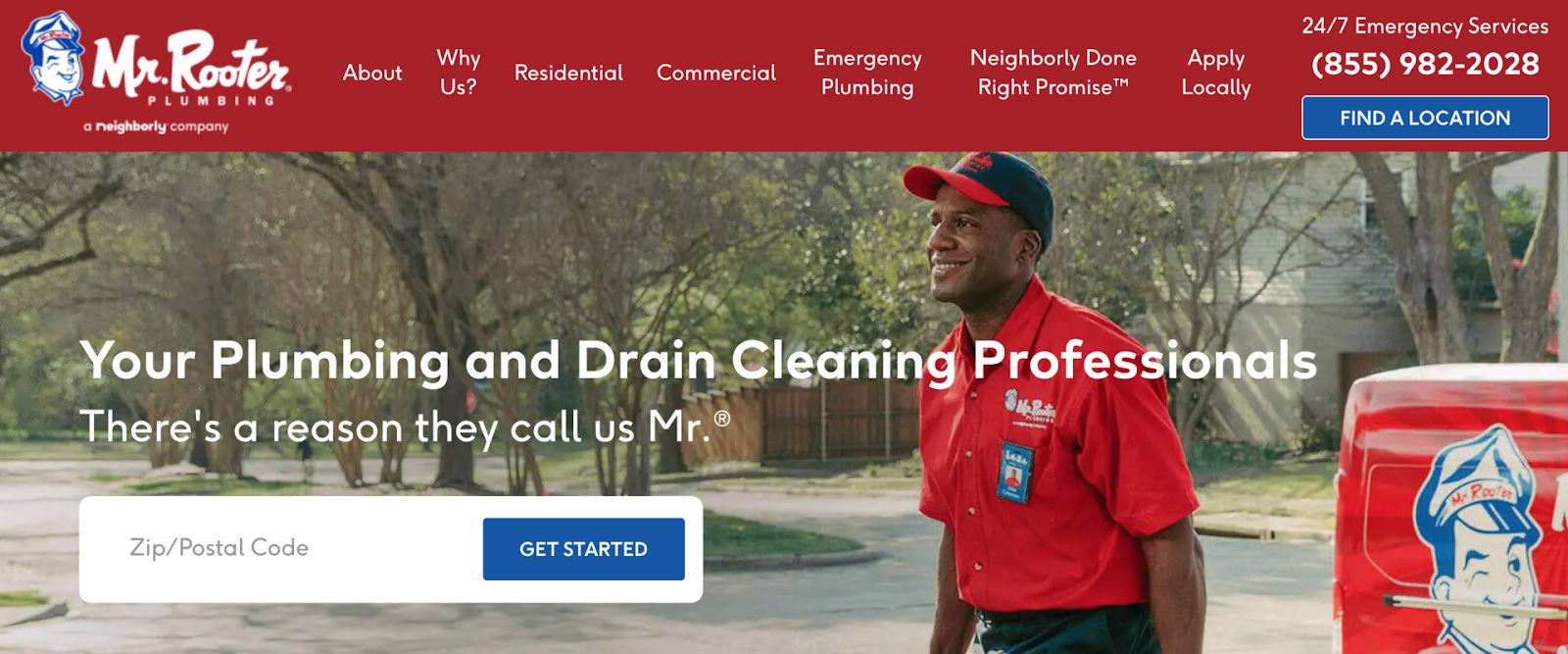
4. Organic Keywords That Include Your Geography
Most potential clients begin their customer journey on the search engine results page (SERP). A potential customer is looking for a home service within their area that can respond quickly to their needs with a reputation for providing quality work. If you want to rank on the search engines, you need to include keywords that apply to your target market. They're a crucial part of any search engine optimization (SEO) strategy.
A good way to do this is by adding geo modifiers. For example, if your business only serves customers in Atlanta, Georgia, use key terms like "plumbing services in Atlanta." It's a fast and easy way for anyone looking on Google or social media to find you. If you're looking to attract customers from other regions, make sure to add modifiers like "plumbing services in Georgia" or "plumbing services near me."
Professional online marketing services will often do keyword research to find out what people are searching for. For instance, an SEO service can help you determine what keywords to use for your plumbing company's website as well as how many times they should appear in your copy. You can also do this yourself by using tools like Google's keyword planner.
Example
When you visit GM Plumbing Corporation's website, you know where they're from and what they do. Immediately, you see they are from Long Beach and offer quality plumbing services. That's the kind of organic geo-focused keyword usage you should employ in your own plumber website design.
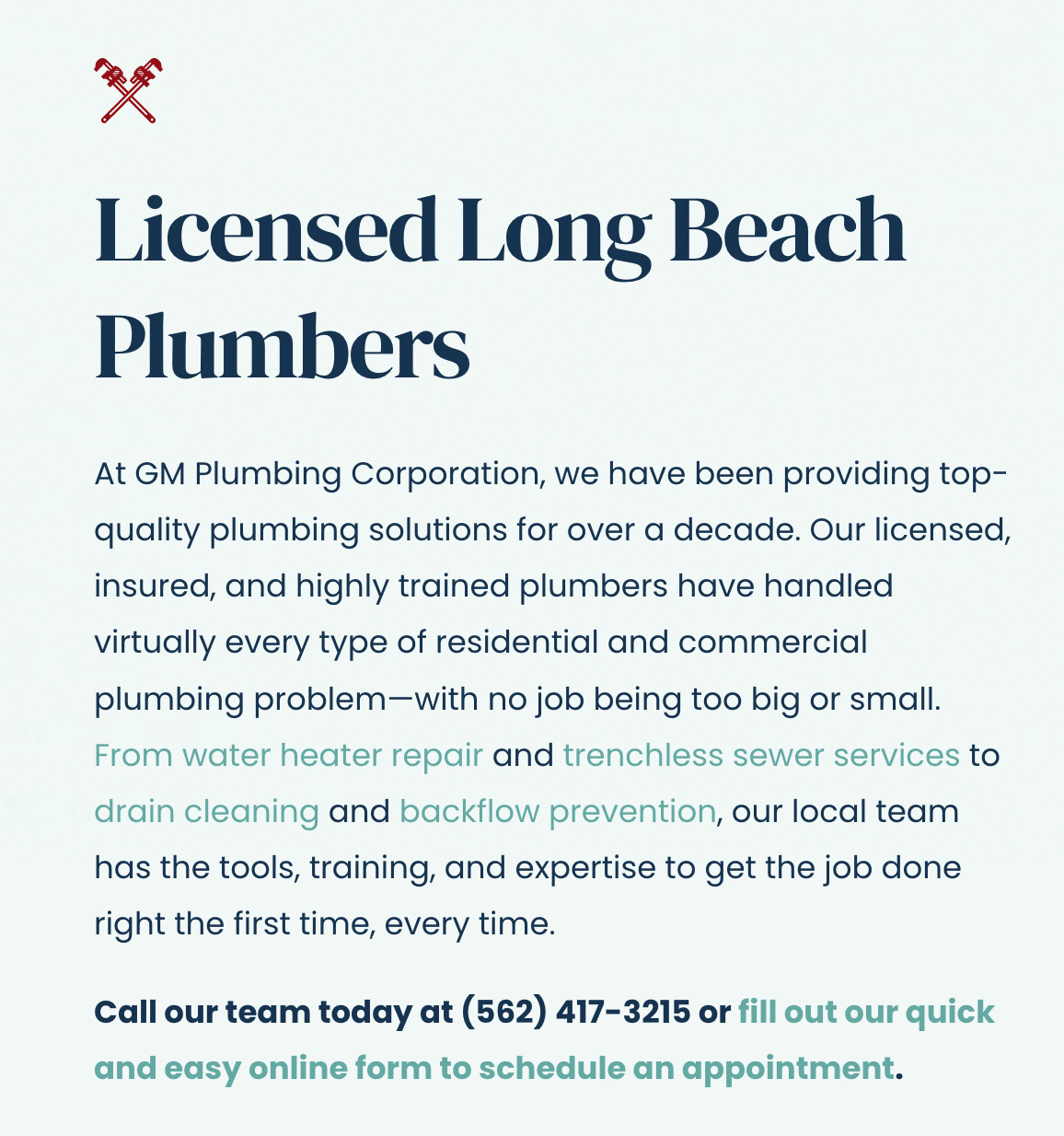
5. Services Offered on the Front Page
Your customers should know at a glance what services you offer, and they should be able to easily navigate to the page that lists them all. If they're not sure what kind of plumbing job they need done, but have a basic idea that it's something related to pipes or water supply, then your homepage should have a list of common services offered by plumbers.
You can also use this space as an opportunity to highlight any specialties or certifications your company has received, such as being licensed and insured or having experience with specific types of projects. Keep in mind that you can use your Google Analytics page to see what services tend to interest your customers the most and plan your website accordingly.
Example
Cypress Street Plumbing does this particularly well. Their services are organized into categories, making it easy for their customers to find what they’re looking for. Customers can identify what their problem is and find it on Cypress's page, greatly simplifying the process of finding a plumber.
The company also has a section on its homepage that highlights testimonials from happy customers and lets them know how much they appreciate their business.
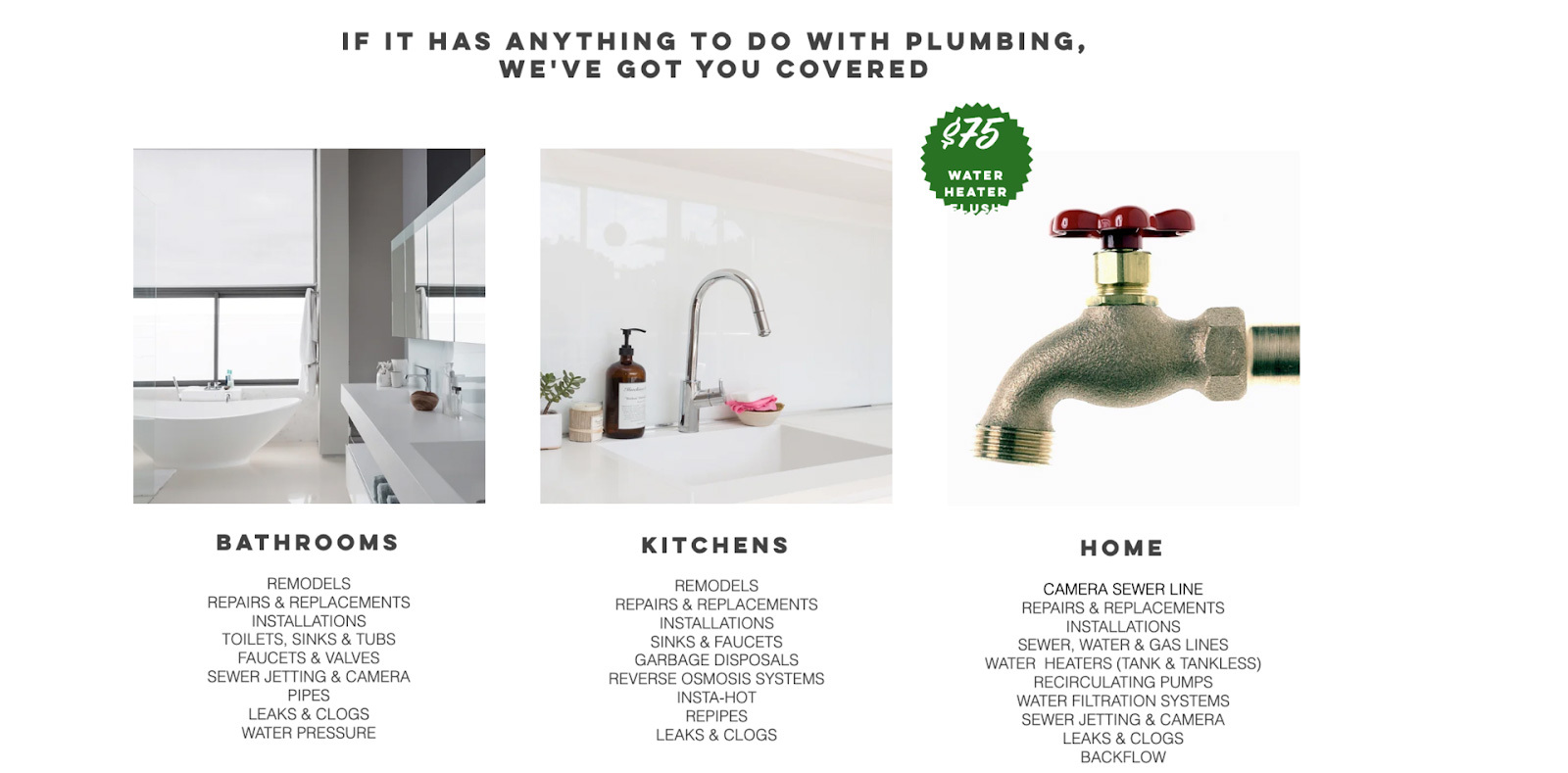
Start Building a Great Plumbing Website
Start with a solid foundation and build on it: think about why potential customers are visiting your plumber website, what they're looking for, and how you can meet those needs. Then, incorporate the tips above to create a website that represents your business well and provides the information your potential customers are looking for. If you do those things, you'll be well on your way to growing a successful plumbing business.
If you'd like more help, work with Scorpion. We have years of experience creating responsive website designs for plumbers and other home services professionals. Visit our website to learn more about our services today.
.0000000000000.jpg)

.jpg)

.jpg)